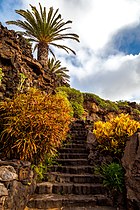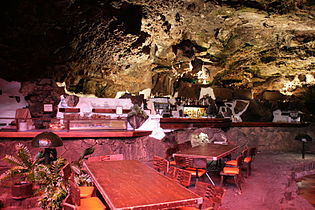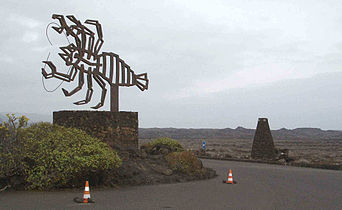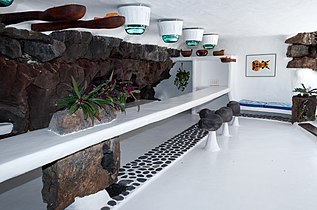Jameos del Agua

Jameos del Agua is the name of by the artist and environmentalist César Manrique built in 1966 arts and cultural center and tourist attraction in northern to Spain belonging Canary Island of Lanzarote .
The partially collapsed lava tube , located in the lava field of the Monte Corona volcano , has been developed here and equipped with a pool, restaurants and event facilities. The entire lava tube stretches from Monte Corona via the accessible cave Cueva de los Verdes , on to Jameos del Agua to the coast below the surface of the sea.
history
The word Jameo comes from the old Canarian vocabulary and means something like cavity or depression in the ground. The core of this cave system, which is located in the island community of Haría , is an underground lava tunnel that was created by the solidification of the lava masses in a process that dates back around 3000 to 4500 years. In the early 1960s, the island government decided to transform the lower part of the cave, the ceiling of which had partially collapsed, into a center of art, culture and tourism. This project was directed and designed by the Lanzarote architect, artist and conservationist César Manrique . The facility was opened in 1966.
Character of the Jameos del Agua
The planted entrance to the cultural and tourist site is via a curved, steep staircase to the restaurant in the grotto, where you can look from the terrace over the underground lake, in which a white crab ( Munidopsis polymorpha ) lives, which otherwise only lives occurs in oceanic depths of over 2000 meters and reaches a length of about 1.5 cm. The water level of the lake rises and falls with the tides , as the grotto, although it has no direct connection to the sea, is fed by sea water that seeps through the rock.
From the lake, a planted stone staircase leads up to the white swimming pool, which was specially designed for this setting by César Manrique, but is no longer used for swimming today. The pool is fed by a small artificial waterfall. Rare and sometimes endemic plants grow around the basin. A stone staircase leads up to the House of Volcanoes , where the volcanic processes of Lanzarote are explained. From a restaurant with a partially covered terrace, you have a view of the grotto, the pool and the wide lava landscape outside Jameos del Aqua.
Behind the white basin is the centerpiece of Jameos del Agua, a concert hall integrated into the grotto with around 600 seats, which was closed between 2001 and 2009 to introduce new safety standards. Since February 15, 2009, the event hall, called Los Jameos, has been used again by visitors to the cultural and tourism center of the same name.
Tunnel de la Atlantida
At the lower end of Jameos del Agua is the only access to the completely water- flooded Túnel de la Atlántida . Here the cave system continues and ends after about 1400 meters about 50 meters below the sea surface in a dead end. Around ten diving expeditions explored this tube between 1983 and 2008 and discovered around fifty, partly still unknown and endemic species of pigmentless and eyeless cave animals, including representatives of the exclusively cave-dwelling Remipedia .
The Lanzarote Geodynamic Laboratory has installed some measuring instruments in the Túnel de la Atlántida to monitor and research a possibly rising sea level. It also operates another research laboratory in the House of Volcanoes here in Jameos del Agua as well as a 2500 square meter visitor center, where guided tours are also offered.
photos
Web links
- Website with detailed information on the Jameos del Agua and other architectural works by Manrique.
- Explanatory drawings by Jameos del agua , as well as other art centers in Manrique in Lanzarote.
-
Interactive map of Lanzarote with the location and explanations of the Jameos del agua and the rest of Manrique's works on the island.Commons : Jameos del Agua - Collection of images, videos and audio files
Individual evidence
- ↑ Canarian weekly newspaper of February 8, 2009: Auditorio Los Jameos finished , accessed on July 1, 2015
- ↑ Lanzarote 37 ° - Expedition Atlántida: The secret tunnel of the Jameos del Agua; December 2008 , accessed July 1, 2015
Coordinates: 29 ° 9 '25 " N , 13 ° 25' 55.4" W.






